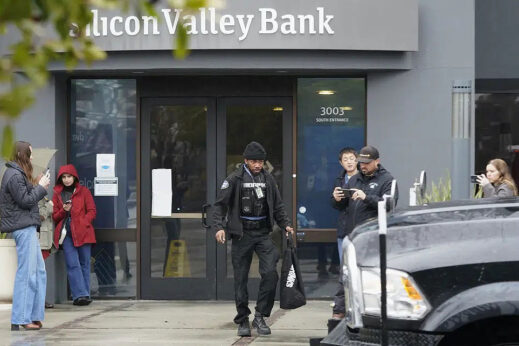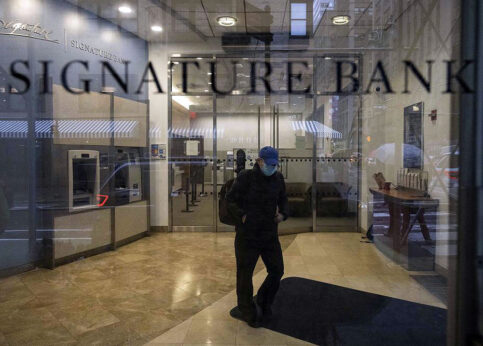Finance capital seems poised to once more drag the country into a new banking crisis, dredging up the specter of the 2008 collapse of Lehman Brothers and the Great Recession that it sparked. Since Friday, the U.S. government has seized control of two banks in an effort to slow the development of a classic “run on the banks” situation.
The first hint of a crisis emerged Wednesday last week when Silicon Valley Bank (SVB) in California disclosed that it had sold a large number of its U.S. Treasury Bonds at a steep loss so it would have enough cash to cover recent customer withdrawals.
SVB was established four decades ago and was the preferred bank of the technology companies and venture capital start-ups that give Silicon Valley its name. It grew to become the 16th largest bank in the country.
Since it catered to the tech sector, SVB’s financing was in high demand through the years of the COVID-19 pandemic as consumers stuck at home during lockdowns sought out digital gadgets and delivery services. Some top SVB clients included Etsy, Roku, and Vox Media—who deposited their cash for payroll and other business expenses.
As all banks do, SVB took those customer deposits and invested them in order to generate interest and dividend profits off the money the bank held. SVB chose to invest large amounts of those deposits into long-dated government bonds, including ones backed by mortgages. Since the bonds are issued by the U.S. Treasury, they are generally considered safe investments.
A consequence of interest rate hikes
Trouble started brewing for SVB’s strategy, however, when the Federal Reserve started raising interest rates, the government’s preferred strategy for combatting rising prices. But bond prices move inverse to interest rates—as the rates rose, bond prices fell. This meant that the value of SVB’s investment portfolio steadily dropped over the months with each new rate hike.
Had the bank been able to hold onto these bonds for several years, until their maturity date, there would have been no problem. But as the economy started to show signs of stress in the past year, with the pandemic tech start-ups affected the most, a lot of SVB’s customers started to withdraw their money to cover their own increased costs.
To get the quick cash it needed to cover those withdrawals, the bank started selling off its U.S. Treasury bonds. But because of their decreased value, SVB was selling at a loss, receiving back only a fraction of what had been invested. The bank disclosed this situation on Wednesday, telling markets that it needed to raise $1.75 billion in capital to plug the hole. That announcement set off the panic.
Not only was no one interested in buying SVB’s new shares, the stock market actually responded with a sell-off of already-existing SVB shares. The company’s stock price plummeted 60% before trading was halted.
Related Story: The Fed’s intentional recession: Higher interest rates mean fewer jobs, smaller paychecks
Fearful that SVB was no longer a secure place to hold their money, more customers raced to withdraw. Fariborz Moshirian, the director of the Institute of Global Finance at the University of New South Wales, told the press, “Suddenly, everyone became alarmed that the bank was short of capital.”
Over the next 48 hours, the $200 billion company bled cash. It couldn’t keep up with the outflow of deposits. And since SVB’s clients are large companies—not the households and small businesses that keep their money in local branches—the amounts pulled out were huge. On Thursday alone, over $42 billion was withdrawn.
By Friday, news broke that the bank was bankrupt and being seized by the federal government. It is the largest bank failure since the global financial crisis and the second largest in U.S. history.
The contagion
Immediately, fears spread that the problem might not be limited to just SVB.

What if other banks made similar bad investment decisions with customers’ deposits? Could soaring interest rates put more banks in danger? Will the millions of Americans who deposit their paychecks in local Main Street branches become afraid of losing their savings and keep cash under the mattress? Might the SVB collapse be the beginning of a wider systemic financial crisis?
The fact that a top SVB executive, Joseph Gentile, had been an executive at Lehman Brothers—the bank whose collapse initiated the Great Recession—became a symbol of the continuing domination of a stratum of gamblers sitting atop the class of finance capitalists. One commenter on Twitter responded, “You can’t make this up.” Another wrote, “It all makes sense now.”
The government moved quickly to try to calm fears and contain the fallout. The Federal Deposit Insurance Corporation took control of the bank. But the FDIC only guarantees deposits up to $250,000—less than half of what many clients had in their SVB accounts. That liability cap contributed to fears that if more banks collapse, substantial sums of money could just vanish.
Bank stock futures declined throughout the weekend, fueling the panic. On Sunday morning, the government declared it was seizing a second bank, New York-based Signature Bank, to prevent another collapse. Signature’s customers are mostly law firms, which often use escrow accounts to hold their clients’ money for real estate transactions and other legal proceedings.
Who gets bailed out, and who will pay?
To shore up confidence, a trio of the top financial regulators in the U.S. jointly announced emergency measures Sunday. Treasury Secretary Janet Yellen, Federal Reserve Chair Jerome Powell, and FDIC Chair Martin Gruenberg gave a guarantee that all SVB and Signature depositors would be able to access their money Monday morning, with no one limited to just the $250,000 cap set by FDIC policy.

The costs, they said, would be covered by a special $25 billion Emergency Stabilization Fund that already exists. They also promised the government would extend credit to other banks to ensure they are not subject to the same risks that killed the other two banks.
What that means is that banks will be allowed to borrow essentially unlimited amounts from the Federal Reserve for at least the next year, with the loans covered by “safe” government securities.
Though possibly unavoidable now that the situation has reached a crisis point, what’s happening is that the government is loaning money to banks to allow them to avoid selling their U.S. Treasury bonds—the same bonds which have lost value because of the government’s own high interest rates.
It’s an absurd update of the “too big to fail” bailout circle that defined the last great financial collapse. The government’s response gives banks access to bottomless amounts of capital while working people are left to deal with the consequences of crushing interest rates and inflation all on their own.
There is no emergency fund to help families who are unable to afford their mortgages because of exploding interest payments. There are no bottomless buckets of cash for the people who can’t afford groceries. And when the Supreme Court likely kills student debt relief later this year, there won’t be any bailout fund for all the people who will be hit by their own personal financial crises.
The moves by regulators potentially involve trillions of dollars taken from public coffers, posing the question of whether, yet again, the people of the United States will be on the hook to cover the losses resulting from the financial recklessness of the capitalist class.
Anticipating that, the statement from the government claimed, “No losses associated with the resolution of Silicon Valley Bank will be borne by the taxpayer.” There is discussion of some special insurance assessment that will be made on all banks to cover the program’s costs, but, again, details have yet to surface.
The role of Trump and Congressional Republicans
SVB’s woes have also put the spotlight back on Congressional Republicans and former President Donald Trump, who repealed sections of the Dodd-Frank banking reform bill in May 2018. It had sought to tighten up the loose lending and risky strategies by financial institutions that caused the Great Recession.
Dodd-Frank had limited banks’ ability to use their clients’ deposits for speculative investments. Without any such restrictions, banks could fund their risky bets with customers’ money and then, if the gambling went bad, turn to the FDIC to cover their losses.
Banks spent years lobbying to throw out the legislation, and with the help of Trump and the GOP, they succeeded.
Sen. Elizabeth Warren, D-Mass., who fought to stop the repeal, wrote in the New York Times on Monday that “Congress, the White House, and banking regulators should reverse the dangerous bank deregulation of the Trump era.” She said the Republicans had “weakened the rules for banks like SVB.”
California Democratic Rep. Katie Porter said she’s already drafting legislation to reverse the 2018 law. “Congress caved to Wall Street and loosened our nation’s banking laws,” she said in an email on Sunday.
President Joe Biden also said in a Monday speech that the deregulation law played a key role in sparking the current crisis and called on Congress to tighten rules on banks. Little cooperation is expected from the Republican-run House, however.
The original Dodd-Frank bill had classified all banks with assets of $50 billion or more as “too big to fail,” and subjected them to increased scrutiny. The GOP repeal raised that threshold to $250 billion, exempting medium-sized banks like SVB.
Warren said that if Congress and the Federal Reserve had not rolled back the stricter oversight, “SVB and Signature…would have been required to conduct regular stress tests to expose their vulnerabilities.”
Sen. Bernie Sanders, Ind-Vt., was even more direct: “Let’s be clear. The failure of SVB is a direct result of an absurd 2018 bank deregulation bill signed by Donald Trump.” Sanders pointed out that five years ago, even the Republican Director of the Congressional Budget Office warned that the legislation would “increase the likelihood that a large financial firm with assets of between $100 billion and $250 billion would fail.”
That is precisely that category that the $200-billion SVB occupied. It, along with other mid-size and smaller community banks, carried out some of the most intense lobbying to win the repeal by Congress.
Monopoly marches on
Yellen tried to distinguish the current situation from the 2008 banking collapse. “The American banking system is really safe and well-capitalized,” she said on CBS on Sunday. “Americans can have confidence in the safety and soundness of our banking system.” She’s right that the system is “well-capitalized.” Profits for many sectors of big business have grown exponentially in the last few years, resulting in bulging corporate bank accounts.
And the biggest of the big banks will probably benefit, at least initially, from the troubles at mid-size banks like SVB and Signature. Many clients will start moving their money to the largest financial institutions, which are still seen as stable and safer. So, these bank collapses could speed up a monopolization tendency for a time, a greater concentration of capital at the top of the banking sector. A sell-off of regional bank stocks on Monday suggests the process is well underway.
As for what happens next, no one appears sure whether the U.S. government’s moves will be enough to calm rattled nerves. Some stock market activity suggests that many investors believe the banking crisis will push the Federal Reserve to back off from its program of aggressive interest rate hikes.
Moshirian, the UNSW financial analyst, doesn’t think the banking system as a whole is at risk, but he noted that “people also initially felt the sub-prime mortgage crisis was contained.” It went on to result in the global financial crisis. The risk advisory firm Kroll also said it is “unlikely that an SVB-style bankruptcy will extend to the large banks.” It said small community banks are still at risk, however.
Speaking to the central organ of the U.S. capitalist class, The Wall Street Journal, investment manager Frederic Russell said the practices that led to SVB’s collapse aren’t uncommon. He pointed out the fact that for months before its collapse, SVB didn’t bother to fill its vacant risk management officer position. “Banks get thrown into the dark pool of complacency,” he said, “and then they lower their quality standards.”
He warns that SVB “could be the first cockroach in the cellar.”










